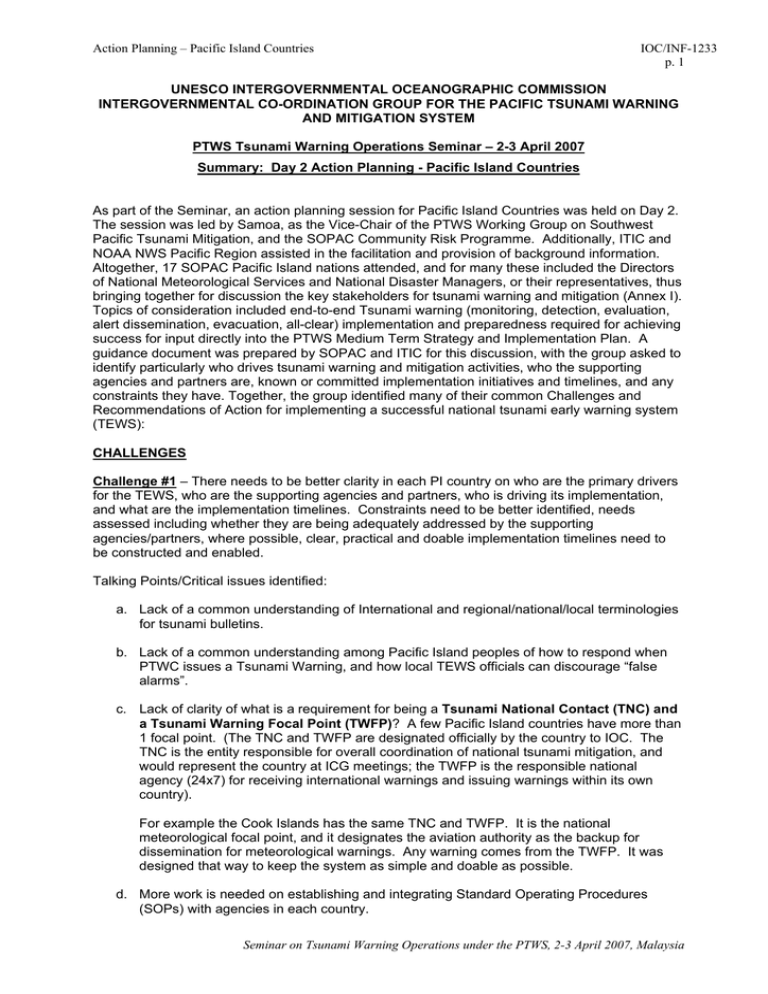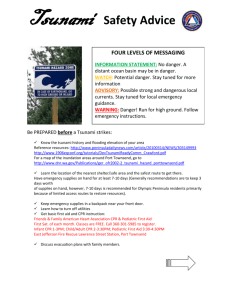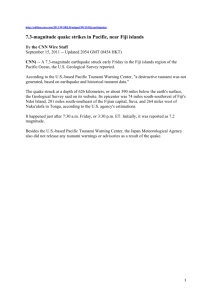Action Planning – Pacific Island Countries IOC/INF-1233 UNESCO INTERGOVERNMENTAL OCEANOGRAPHIC COMMISSION
advertisement

Action Planning – Pacific Island Countries IOC/INF-1233 p. 1 UNESCO INTERGOVERNMENTAL OCEANOGRAPHIC COMMISSION INTERGOVERNMENTAL CO-ORDINATION GROUP FOR THE PACIFIC TSUNAMI WARNING AND MITIGATION SYSTEM PTWS Tsunami Warning Operations Seminar – 2-3 April 2007 Summary: Day 2 Action Planning - Pacific Island Countries As part of the Seminar, an action planning session for Pacific Island Countries was held on Day 2. The session was led by Samoa, as the Vice-Chair of the PTWS Working Group on Southwest Pacific Tsunami Mitigation, and the SOPAC Community Risk Programme. Additionally, ITIC and NOAA NWS Pacific Region assisted in the facilitation and provision of background information. Altogether, 17 SOPAC Pacific Island nations attended, and for many these included the Directors of National Meteorological Services and National Disaster Managers, or their representatives, thus bringing together for discussion the key stakeholders for tsunami warning and mitigation (Annex I). Topics of consideration included end-to-end Tsunami warning (monitoring, detection, evaluation, alert dissemination, evacuation, all-clear) implementation and preparedness required for achieving success for input directly into the PTWS Medium Term Strategy and Implementation Plan. A guidance document was prepared by SOPAC and ITIC for this discussion, with the group asked to identify particularly who drives tsunami warning and mitigation activities, who the supporting agencies and partners are, known or committed implementation initiatives and timelines, and any constraints they have. Together, the group identified many of their common Challenges and Recommendations of Action for implementing a successful national tsunami early warning system (TEWS): CHALLENGES Challenge #1 – There needs to be better clarity in each PI country on who are the primary drivers for the TEWS, who are the supporting agencies and partners, who is driving its implementation, and what are the implementation timelines. Constraints need to be better identified, needs assessed including whether they are being adequately addressed by the supporting agencies/partners, where possible, clear, practical and doable implementation timelines need to be constructed and enabled. Talking Points/Critical issues identified: a. Lack of a common understanding of International and regional/national/local terminologies for tsunami bulletins. b. Lack of a common understanding among Pacific Island peoples of how to respond when PTWC issues a Tsunami Warning, and how local TEWS officials can discourage “false alarms”. c. Lack of clarity of what is a requirement for being a Tsunami National Contact (TNC) and a Tsunami Warning Focal Point (TWFP)? A few Pacific Island countries have more than 1 focal point. (The TNC and TWFP are designated officially by the country to IOC. The TNC is the entity responsible for overall coordination of national tsunami mitigation, and would represent the country at ICG meetings; the TWFP is the responsible national agency (24x7) for receiving international warnings and issuing warnings within its own country). For example the Cook Islands has the same TNC and TWFP. It is the national meteorological focal point, and it designates the aviation authority as the backup for dissemination for meteorological warnings. Any warning comes from the TWFP. It was designed that way to keep the system as simple and doable as possible. d. More work is needed on establishing and integrating Standard Operating Procedures (SOPs) with agencies in each country. Seminar on Tsunami Warning Operations under the PTWS, 2-3 April 2007, Malaysia Action Planning – Pacific Island Countries IOC/INF-1233 p. 2 For example, in Vanuatu, it is a matter of setting up institutional arrangements within each country, e.g. posting warnings in local languages. It may take 2-3 agencies to come up with the warning message. From the IOC/PTWS prospective, the TWFP receives messages from the PTWC, JMA, and WC/ATWC and has the responsibility to act nationally upon its receipt; this action can be to inform the NDMO and/or to inform the people directly with the public safety action they should take. Because tsunamis are rapidly-onset events, pre-planned responses and authoritative arrangements for action and reaction have to be in place beforehand; standard operating procedures are tools to enable fast, efficient responses. Assistance in building and strengthening capacities is organized and led by the IOC ITIC, who can work directly with PTWS Member States to provide services. However, a number of PI countries are not officially members of the PTWS Intergovernmental Coordination Group (ICG). This requires being a member of the Intergovernmental Oceanographic Commission. No monies are required for membership. This paperwork formality ensures that that the IOC receives the official designation of the Tsunami National Contact (TNC) and Tsunami Warning Focal Point (TWFP) from each country. e. Still a need to know at what scale does a tsunami not interact with an island, versus when there is a tsunami runup on an island. This will require numerical modelling studies and these will require resources that are not currently available. More work is then needed on establishing and integrating these scenario results into the Standard Operating Procedures (SOPs) with agencies in each country. f. Need within Pacific Island countries to identify current sea level gages, their locations, what international programs funded them and for what purpose, where there are gaps in the Southwest Pacific, and what resources are available to meet national PIC requirements. g. Need to issue a local Tsunami bulletin with as much detail as possible, and with a standard set of expected guidelines for action using common lexicon (definitions of words). Pacific Island countries require guidance on how to issue these bulletins. Action scenarios are required by island residents, is no action required, and what content in PTWC bulletins can PI countries then put in content that requires local action? Need for more modeling to decide what is the critical size for an island to be small, i.e., when does a tsunami go around an island without a runup (surface area versus bathymetry). h. Need to develop common codes for warning messages across hazards and common across international and national jurisdictions. Hydrometeorological warnings may already have an existing set of color codes already recognized by islanders. i. Need to use consistent map-scales. For example, currently there is inconsistent use of kilometers vs. miles or nautical miles, and imperial vs metric system. (it is recommended to use the metric system for the tsunami warning system). It should be considered whether it is possible to tie/link the PTWC warning currently for broad areas to subregional zones in national bulletins. However, for NDMOs, the emphasis is on getting the warning out to local communities. Terminologies and metric vs English system are not as important as getting the message out. j. Need to develop a common base of knowledge across Pacific Island national agencies and departments and all stakeholders within each country, which include NGO’s, and to use previous hazard and vulnerability analyses that are based on each island’s historic data, physical, paleo-tsunami inferences, and socio-economic data. This requires sharing of data in a continuous and systematic manner, and may require MOUs and establishment of new policy and regulations. Seminar on Tsunami Warning Operations under the PTWS, 2-3 April 2007, Malaysia Action Planning – Pacific Island Countries IOC/INF-1233 p. 3 k. Need to map out national, regional, and local responsibilities, need for legislation and development of plans for all relevant organisations and departments, including the Red Cross, traditional and elected/designated leaders, for relationships and roles for tsunami preparedness, warning and response from national to local/last kilometre (people-centred and community-based processes). Most National Meteorological Services operates 24 hours per day/7 days per week. Need to explore options to use pagers/alarms for other responders, i.e. conduct of national assessments/ feasibility studies should help to define needs, identify gaps, and explore practical solutions through, at a minimum, pilot projects. EMWIN and RANET may be practical and proven tools for information receipt. l. Need to coordinate risk and needs assessments, and gain support from all stakeholders. Urgent need is to establish common SOPs for dissemination to the public that will support communities to do their own risk assessments, with the subsequent planning, implementation. These types of champions can be used as frontline observers for local warning and verification means. Encourage the widespread use of the PTWS Assessment Questionnaire as the “needs assessment tool” for tsunami capacity assessment. This tool was originally developed and used by ITIC and SOPAC CRP for the 2004 Southwest Pacific Tsunami Awareness Workshop, and subsequently expanded and used to conduct about 20 missions in the Indian Ocean by the IOC. The Australian Bureau of Meteorology is using this tool as a basis for conducting PIC assessments in 2007. Challenge # 2 – Each Pacific Island country has Communication Challenges. a. There are many communications challenges that exist across agencies at the local and national levels, and extend out to many remote, high risk communities. b. Needs for national assessments of existing redundant communications systems used by the meteorological services, the emergency responders, such as police, fire, PWD, hospitals, Red Cross etc. c. Need more use of traditional means to convey warning messages, such as the use of lali drums, church bells as well as utilizing modern dissemination methods, such as EMWIN, RANET, National weather radio communications, AHAB, HF communications, Emergency Alert Systems (where available), national hotlines (such as the US National America Warning Alert System), facsimile, mobile phone technology, satellite, Internet, etc. These systems should all have their own integrated needs assessments for their effectiveness for Pacific Island countries and use in villages with various capacities. When choosing a method of communication, consideration needs to be given on the different operational requirements for information delivery (e.g., how fast, how reliable, how robust), as well as costs and long-term sustainability. d. Need to conduct regular National (local?) and Regional exercises (1-2 years?). Challenge #3 - There are many Outreach Tools, but they are not being fully utilized. a. Inconsistent use of available outreach tools, such as Tsunami Teacher, Tsunami Awareness Kits, Tsunami Travel Time programs (TTT software), ITDB (Interactive historical Tsunami Database, sea level tools (Tidetool Sea Level Decode and Display, CSIN/RTED real-time earthquake displays). b. Training opportunities to fully utilize these tools are not available, yet are required in order to be fully understood and then used as a resource by local decision makers. Challenge #4 - Interoperability issues between all (developing) hazard Warning Centres, and all available detection equipment and other systems (PTWC, JMA, ATAS, PGOOS, etc). Challenge #5 - Relationship strengthening is needed by warning authorities with their respective media, and with the international media. Seminar on Tsunami Warning Operations under the PTWS, 2-3 April 2007, Malaysia Action Planning – Pacific Island Countries IOC/INF-1233 p. 4 RECOMMENDATIONS Upon identifying challenges, the Group offered the following Recommendation for Action: 1. All PICs should join the Intergovernmental Oceanographic Commission and the ICG/PTWS, and World Meteorological Organization and the WMO RA-V, as a collective early warning systems strategy. 2. All PICs to develop Contingency Plans for the Emergency Operations Centres that include a backup power generator AND backup fuel. All PICs should seek to implement redundant communications methods to ensure priority emergency information can be received and transmitted to key responsible authorities. 3. ITIC to provide country specific Travel Time maps, or other means of information to allow countries to know when tsunamis are expected from various source regions. 4. Enable a small group to develop a PI report that provides an overview based on consultations and input from individual countries. Existing mechanisms to consider are through the SOPAC CRP or STAR Tsunami Working Group, SPREP RMSD Working Group, and/or the PTWS SW Pacific Tsunami Mitigation Working Group. 5. Identify 2-3 key issues that are critical to the development of PI national warning systems. The same group as in 4 could facilitate this. 6. Make use of conference calls on specific topics to articulate recommendations that can be brought forward to SOPAC NDMO and SPREP RMSD upcoming meetings, and then brought forward to the next PTWS ICG/PTWS-XXII meeting in Ecuador (17-20 Sept 2007). 7. Clarify roles for the regional organizations and their Working Groups, e.g. WMO Region V/IOC/PTWS) should work closer together to assist Pacific Island countries develop their national tsunami warning system….as well as other hazard warning systems/programs. Consider consolidated with common Terms of Reference that link directly to the responsibilities of the different regional organizations and WGs. 8. Further refine the Early Warning Strategy to specifically establish national tsunami warning capability. In some cases, countries will be entirely reliant on regional warning centres to provide the warning message to a national sovereign authority, and in other cases consider sub-regional mechanisms. 9. SW Pacific Tsunami Needs Assessment – ensure that current urgent priorities and issues are addressed when the teams arrive within each country. After the Solomons Islands tsunami, the government requested assistance in establishing tsunami early warning arrangements to the ITIC. 10. Regionally, encourage key stakeholders to come together to discuss common issues. Facilitate this through cooperative arrangements and agenda-making of existing regional organization meetings (PTWS, WMO RA-V, SOPAC, SPREP, etc). Encourage full notification of all stakeholders of the various meetings. One action can be to re-organize the RMSD meeting to address the Met Service’s roles in tsunami warning system, and work closely with SOPAC and the NDMOs. Practical suggestions are to have SOPAC NDMO and SPREP RMSD meetings occur in the same country at the same time to allow overlap on common early warning system issues. Compiled by Edward Young (US NOAA NWS), Noud Leenders (SOPAC CRP), Laura Kong (ITIC) ANNEX I. Seminar on Tsunami Warning Operations under the PTWS, 2-3 April 2007, Malaysia Action Planning – Pacific Island Countries IOC/INF-1233 p. 5 Pacific Island Country participants to the PTWS Tsunami Warning Operations Seminar IOC SEMINAR ON TSUNAMI WARNING OPERATIONS UNDER THE PACIFIC TSUNAMI WARNING AND MITIGATION SYSTEM (PTWS): Protocols, Procedures and Best Practices for Monitoring, Evaluation and Alerting the Public 2-3 April 2007, Petaling Jaya LIST OF PARTICIPANTS – PACIFIC ISLAND COUNTRIES AUSTRALIA Dr. Terry Hart Head, Disaster Mitigation and Severe Weather Services Bureau of Meteorology E-mail: t.hart@bom.gov.au Dr. Linda Anderson Berry National Program Manager Disaster Mitigation and Emergency Management Co-ordinaation Bureau of Meteorology E-mail: lab@bom.gov.au Dr. Venantius Tsui Superintendent, International Affairs Bureau of Meteorology E-mail: v.tsui@bom.gov.au Mr. Gary Foley Deputy Director (Services and Systems) Bureau of Meteorology E-mail: g.foley@bom.gov.au COOK ISLANDS Mr. Charlie Carlson Emergency Management Cook Islands Office of the Prime Minister E-mail: ccarlson@pmoffice.gov.ck Mr. Arona Ngari FIJI Mr. Prasad Rajendra Director of Meteorology Fiji Meteorological Service E-mail: rajendra@met.gov.fj INDONESIA Prof. Dr. Mezak A. Ratag Director for Research and Development Indonesia Meteorological & Geophysical Agency (BMG) Meteorological and Geophysical Agency E-mail: mezakr@yahoo.com Haji Pariatmono Assistant to Deputy Minister on the Analysis of Science & Technology Needs, Ministry of Research & Technology, Indonesia E-mail: pariamono@ristek.go.id Mr. Endro Santoso Head of Meteorologi Information Division in Meteorological and Geophysical Agency E-mail: endorsan@yahoo.com Mr. Sunarjo Director of Center for Geophysical Data and Information System of Meteorological & Geophysical Agency E-mail: sunaryo@bmg.go.id MARSHALL ISLAND Mr. Lee Jacklick Supervisory Weather Service Specialist Deputy Directory/SWSS Weather Service Office Majuro Email: lee.Jacklick@noaa.gov NEW CALEDONIA FEDERATED STATES OF MICRONESIA Mr. David Arumug Meteorologist-in-charge E-mail: david.aranug@noaa.gov Mr. Nicolas Beriot Director of Meteo-France in New Caledonia and Wallis-and-Futuna METEO-france E-mail: nicolas.beriot@meteo.fr directeur-nc@meteo.fr Mr. Frederic Marchi-Leccia Directeur Securite civile New Caledonie Haut Connissarint de le Republic que Email: loncelot98@netcoumer.com Seminar on Tsunami Warning Operations under the PTWS, 2-3 April 2007, Malaysia Action Planning – Pacific Island Countries IOC/INF-1233 p. 6 NEW ZEALAND Email: lameko.talia@mnre.gov.ws Mr. Charles Pearson Hydrologist National Institute of Water Research E-mail: c.pearson@niwa.co.nz Mr. Saolotoga R. Fasavalu Senior Disaster Management Office Ministry of Natural Resources & Environment Meteorology Division-Disaster Management Office Email: salologa.fasavalu@mnre.gov.ws & Atmosphere Mr. David Coetzee Emergency Management Advisor ULDEM E-mail: david.coetzee@dia.govt.nz SOLOMON ISLANDS NIUE ISLAND Mr. Loti Yates Director, NDMO E-mail: directorndc@solomon.com Mr. Robert Murray Togiamana National Disaster Management Officer Niue Police Department E-mail: Robert.police@mail.gov.nu Mr. Chanel Iroi Director Meteorology Solomon Islands Meteorological Service E-mail: c_iroi@yahoo.com.au PALAU TOKELAU Ms. Dilwei Maria Ngemaes Meteorologist-in-charge Email: maria.ngemaes@noaa.gov Mr. Makalio Ioane Deputy Director Transport & Support Services Tokelau, apia Liaision Office E-mail: maka@lesauba.net PAPUA NEW GUINEA TONGA Mr. Mohihoi Mathew Seismologist Geophysical Observatory E-mail: pmgo@daltron.com.pg Mr. Ofa Fa’anunu Director of Meteorology Tonga Meteorological Service E-mail: afaletau@mca.gov.to Mr. Samuel Maiha Acting Director PNG National Weather Service Email: smaiha@pngmet.gov.pg TUVALU REPUBLIC OF KIRIBATI Mr. Tauala Katea Tuvalu Meteorological Service E-mail: tauala_k@yahoo.com Mr. Moreti Tibiriano Meteorological Service E-mail: kirimet@tski.net.ki; MoretiMaria@Gmail.com Mr. Sumeo Silu Disaster Coordinator National Disaster Management Office E-mail: silumeo@yahoo.ca SAMOA VANUATU Mr. Sagato Tuiafiso Principal Scientific Officer-Weather Services Samoa Meteorology Services E-mail: sagato.tuiafiso@mnre.gov.ws Mr. Job Mala PSO Monitoring and Operations Meteorology Department Email: jsmala@meteo.gov.vu Mr. Talia Lameko Principal Scientific Officer-Geology & Engineering Section Meteorology Division Mr. Job Esau Director, National Disaster Management Office Email: jesau@vanuatu.gov.vu Seminar on Tsunami Warning Operations under the PTWS, 2-3 April 2007, Malaysia





